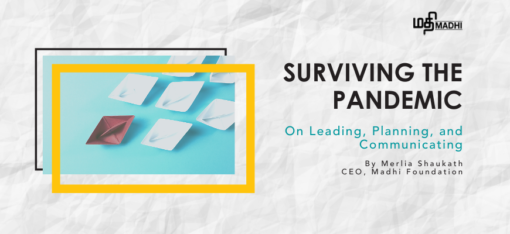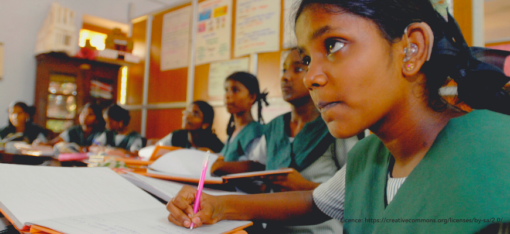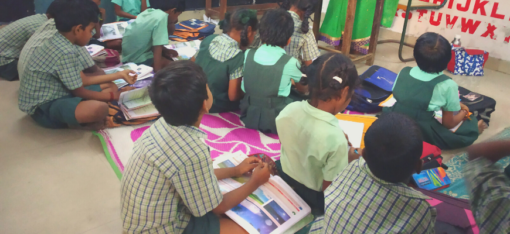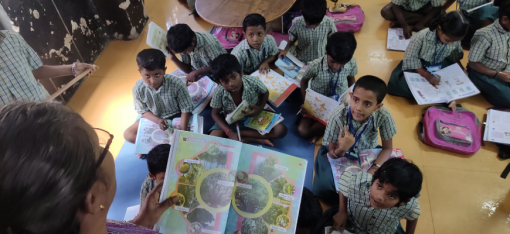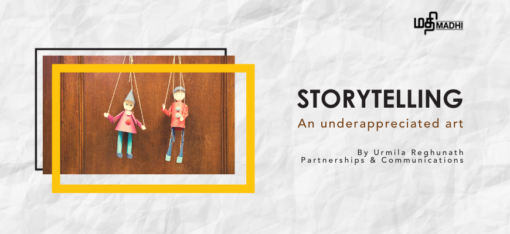
Storytelling – An underappreciated art
If someone asks me whether I am a storyteller, I’d say no.
Truth is, stories pervade the cracks of all our everyday lives. We narrate incidents, needs, and hopes, amusing and informing anyone who would listen. Almost unconsciously, our brains stitch together disconnected events, transforming them into personalised tales of interest. Aren’t we all, then, storytellers?
For NGOs like ours, stories are the translators we rely upon to communicate to you the inspiration and impact that drive our work. Every poster, every proposal, and every conversation, needs to perform this storytelling function for us to be able to expand our reach and build support for our vision. This of course means that storytelling is an essential skill to hone, especially for those of us working with communications, fundraising, and partnerships.
Here are some storytelling challenges and opportunities I’ve encountered through my experimentation with writing and design.
Having a clear intent
Every day, through each poster and document, I am aware of our vision and conscious of aligning every collateral to it. In fact, rarely do we encounter doubts in our minds of the vision behind our content, having passionately committed to work towards the purpose of our organisations. A broad rationale alone, however, is insufficient to successfully tell stories.
It is perhaps useful for us to approach storytelling as a tactic and be purposeful in incorporating its elements into the different strands of our work. This clear intent can lift our communications strategy from its shadows and accord it the attention it deserves.
Making connections
Bring in the human element. Evoke emotions. Build empathy.
Oft heard suggestions as these are, I have always struggled to imagine them beyond the inclusion of emotive photographs while creating communications collateral. I suspect though, that in attempting to communicate the problem, the solution and the impact of our work in disjointed parts, we tend to miss out on an opportunity to elevate the interest of our audience. Instead, building an impactful story arc, and using a central character, emotive language and sensory details, are some tricks that could transform mere words into the beginning of a relationship.
Having just completed my nth reading of the Harry Potter series, I am inclined to take inspiration from JK Rowling, and explore how these gripping elements that built personal connections between millions of readers could be brought into the relatively drab world of PPTs and funding proposals.
Choosing characters
Of course, perhaps the most successful elements of Rowling’s magical masterpiece are the characters. The readers empathise with and root for them, willing the story to an ending we all anticipated, and yet waited for with bated breath.
Could storytelling for nonprofits be that much different? Can we not also be more purposeful in building the characters that carry the story forward, and uncover the layers of emotions they may convey to different demographics of audiences? What a name, a context or an identity can do for a data point is, to stick to the theme, almost magical. The Girl Effect video, is a lauded example of this use of a single character to tell the story of millions.
Marking trends
A lot of the work within the development sector is highly nuanced, and spread across months and years of experimentation. Condensing all that we want to communicate into single posters or paragraphs is not just difficult, but also impossible to do as we touch base with our audience mid-way through a project. How then can we persuade the audience to remember the bits of information they received across a span of months, and understand the trends of growth or improvement conveyed through them?
Carrying forward the tone and characters of a story across multiple collateral could aid in this, even through the subtler aspects of storytelling like the use of brand colours, consistent tone of design and recurring themes. Charity Water, through their social media accounts, does this extremely well through simple yet memorable visuals, and impactful captions.
Every blank page is overflowing with the expectation to be memorable. We want our audience to remember what we said, understand it and be personally impacted by it. In writing and reading for this blog post, I have been re-energised to pinpoint my attention towards telling stories through my work in the development sector. Through the humdrum of a busy work week, it is easy to get lost in the minutiae and spend hours analysing the exact positioning of a line or a dot on a Google Slide deck. Perhaps you can join me in taking a step back every once in a while, reading the stories we tell, and wondering if it is indeed a page turner.

